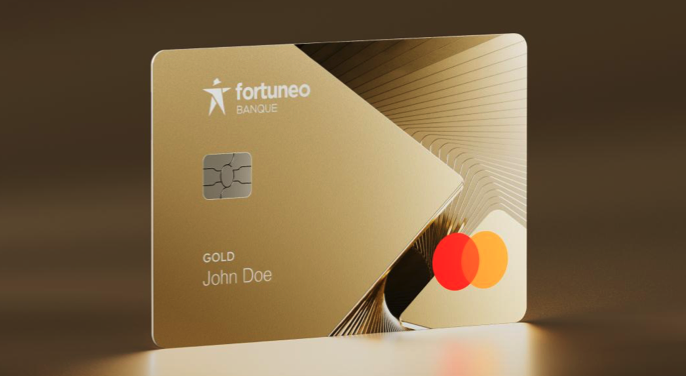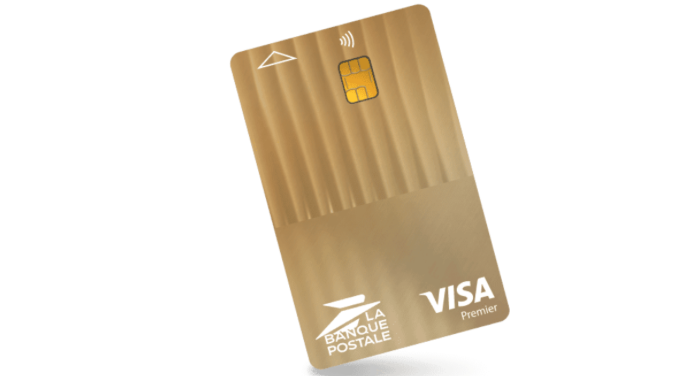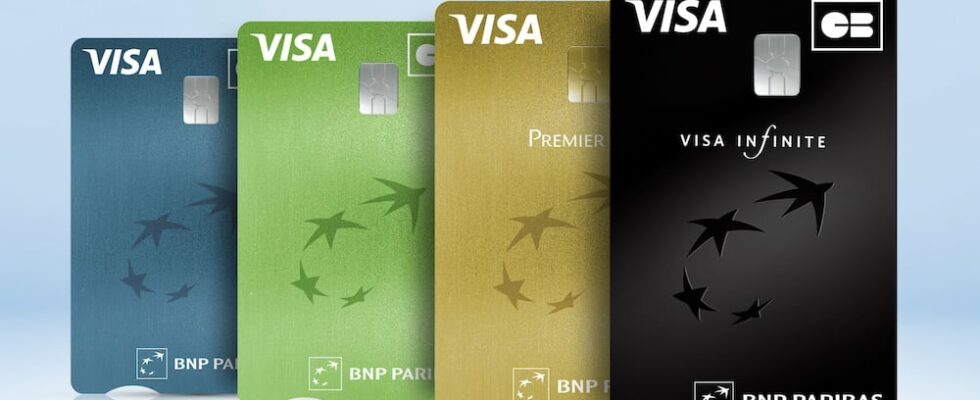Virtually unchanged since its origins, the design of bank cards has evolved significantly in recent years. The unique number traditionally embossed on the front, in particular, tends to disappear. This is the case, recently, at La Banque Postale or at BNP Paribas. We explain why.
What do BNP Paribas, La Banque Postale and Fortuneo have in common? Not much, a priori. The first is a chic and rather Parisian commercial bank; the second, the general public brand par excellence, with its enormous network (7,600 points of sale) and its large customer base (more than 10 million individual customers, including 1.7 in a financially fragile situation); the third is an online bank with rather wealthy customer profiles.
One thing, however, brings them together: all three have, over the last few months, radically changed the design of their cardsby making the number traditionally printed in relief on the front disappear, this unique combination of 16 digits which allows you to distinguish your card from that of your neighbor.


Bank card: what the 16 mysterious numbers written on your credit card hide
A fundamental trend
BNP Paribas, La Banque Postale and Fortuneo are not the only banks, far from it, to have opted for these new look cards and, it must be said, more aesthetic. Banque Populaire, Caisse d’Epargne, Crdit Mutuel Alliance Fédérale, as well as all online banks, have done the same. Crdit Agricole and SG, on the other hand, stick to the classic design. For the moment. Crdit Agricole is considering modifying it, explains its communication. Same story at SG, which has already proposed this type of design for certain [ses] cards released in limited editions: Naruto Itachi metal card in October 2022, or Visa Premier and Infinite metal cards in January 2024.
The movement is therefore launched. The French’s attachment to the physical card remains very strong. The big banks, driven by fintechs, are also trying to innovate. They want to offer more sophisticated objectsnotes Vincent Mouret, Senior Vice-President Product Line & Marketing of the payment section at Idemia, which designs and issues cards for various financial service providers.
With the decline in the use of the checkbook, the card becomes the only material product which connects you to your bank, confirms Meggie Dauvilliers, card product manager at La Banque Postale. Our logo change since March 2022, Editor’s note was the opportunity to offer cards with a purer, more modern design. It’s a underlying trend.
On Fortuneo’s side, the trigger was the desire to propose a recycled PVC card, explains Grgory Guermonprez, director of the online bank. We took the opportunity to change its design. It’s good to do it from time to time.
BNP Paribas: a major change in Visa bank cards
The completely obsolete embossed number
Not all customers, however, are excited about the change. Some people asked us: do we have a choice? confirms Meggie Dauvilliers. The opinion, in fact, is well anchored in people’s minds: a card without a raised number is a low end card, implied to be less reliable. It undoubtedly dates back to the time when only withdrawal or systematic authorization cards, those intended for the youngest or the most modest, were printed and not embossed. However, all our interlocutors tell us: it is completely false.
They are the same cards with the same characteristics. There is no difference in terms of acceptance, the change is absolutely neutral, assures Grgory Guermonprez. Embossing, in fact, had only one use: paying on the shoes, these ancient terminals designed to print the bank card number on a receipt using carbon paper. A technology dating from the 1960s and which has now completely disappeared, supplanted by electronic payment terminals (TPE).
The signature and the magnetic strip on hold
The unique number, however, has not completely disappeared from bank cards. At the Postal Bank, for example, it now appears on the back side new cards, present, not on a horizontal line, but in a vertical column of 4 times 4 numbers, to make it easier to decipher. Easily accessing this number, in fact, remains useful: it is the one you enter when you make a purchase on the internet. However, this is not an obligation. Some cards simply ignore the unique number, like the credit card launched by Apple in 2019.
Other traditional elements could quickly become optional. This is the case of the couple formed by the magnetic track and the signature block. Their presence on cards harkens back to the time of the first TPEs, which appeared in the 1970s, before cards were equipped with memory chips. The payer then had to pass his card through a slide designed to read the information contained in the magnetic track, then sign the receipt given by the merchant to authenticate the purchase.
This way of paying has survived, including in the United States, where it was dominant for a long time and where it has today been supplanted by the chip and contactless. It’s amazing that the embossing, magnetic track and signature block have survived this long. Because, in fact, they no longer serve anything, confirms Vincent Mouret.
Already, Mastercard authorizes French banks to do without the signature block. The magnetic track remains obligatory, but is undoubtedly on hold.
Bank card: do you have to sign it on the back?
The chip and some new features
In the end, only a few elements appear essential today: the name of issuerthat of the wearer, the logo of the acceptance network(s), the anti-counterfeiting hologram imposed by Visa and Mastercard and, of course, the chip now connects an NFC antenna for contactless. The chip is the essential security element on the bank card, the only one that cannot be copied and the one that has made it possible to virtually eliminate fraud during payments in stores, explains Vincent Mouret.
The evolution of bank cards, however, is not just happening in a vacuum. New features appear. Some are purely aesthetic: colored edges, transparency, metal cards… But there are more useful ones.
More and more cards (such as those from BNP Paribas, Crdit Mutuel or Nickel) present a notch which allows visually impaired or blind people to know that they are holding their card the right way. A small step forward, even if the most complicated thing for them, remains to compose their secret code independently on TPEs which are increasingly often deprived of a physical keyboard. Crdit Agricole is trying to provide an answer: in collaboration with the fintech Handsome and Thals, the green bank will deploy Serenipay, a talking card: once inserted into the TPE, it connects to a mobile application, which allows the user to benefit from voice assistance for payment.
A biometric sensor to be able to forget your code
Another innovation will make life easier for those who are tired of memorizing and dialing their 4-digit secret code. THE fingerprint sensor directly integrated into the card allows you to pay without a dial code, without contact and without amount limits.
The innovation is still relatively confidential. In France, it is only offered by BNP Paribas, as an option (24 euros per year) on its Visa Premier card, and by certain local Crdit Agricole banks, again on high-end cards. Is it intended to be democratized? It’s not obvious.
There is a real interest from French banks in the biometric card, explains Vincent Mouret, who knows the subject well, since Idemia was a pioneer on the subject. But he is unlikely that this will become widespread: The cost of a biometric card is 10 times higher than that of a classic card, details Vincent Mouret. It is therefore necessary for the holder to participate financially. There is a market, but it will not concern 100% of bank cards.
How to get a free bank card?
